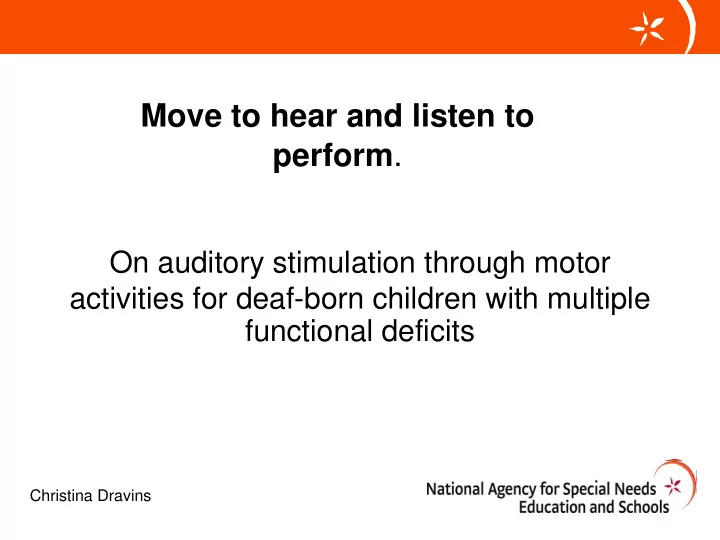

Move to hear and listen to perform . On auditory stimulation through motor activities for deaf-born children with multiple functional deficits Christina Dravins
The technology – cochlear implants • A substitute for the non-functional part of the auditory system (the hair cells of the cochlea) • An electrode array is surgically inserted into the inner ear • Sound is processed to an electrical stimulus pattern in an externally worn sound processor and transmitted to the array • The pattern is transferred to the ganglion cells of the inner ear and further on into the auditory system
A cochlear implant
Programing • Modern, higher-rate, multiple-electrode, sound-coding strategies are selective to promote reception of speech sounds • Speech coding strategies may not fully exploit the perception abilities • Post-lingually deafened adult CI users are not satisfied with their ability to perceive musical sounds – coding of pitch information for CI users is a major problem – rhythmical properties are well preserved – perception of timbre and melody is relatively poor
Pediatric implantation • Early age • Promote development within CNS • ”Reprograming” and ”restructuring” • Deaf-born children have no auditory experience and no auditory memories to facilitate the processing of the signal pattern • Intensive habilitation of children aiming at oral language
Deaf children with artificial hearing Deafness can be a part of a complex disability Picture http://www.faqs.org
Children…. • Who is a ”good” recipient? • Earlier implantation leads to more CI-users with complex needs • Deaf-born children with multiple functional deficits constitute a special vulnerable group with respect to the ability to make use of the input from the CI • If speech is not the primary goal? – Non-speech sounds less audible – Little or no babbling due to motor problems
Rationale – if not speech; why? • Motor actions linked to musical activities may have profound effects on organization of neural networks, • May promote skills that are fundamental for a multitude of mental processes – concentration, motor control, attention span and self regulation • Recreational - for the ” LOL ”s
Ljudskrapan – the concept • Allowing children with mental or physical disabilities to explore their hearing • Consists of a hardware and a software part • Designed to be used by parents and teachers
Pilot study and results • ”Ljudskrapan” has been tried by several children • Early stages of mental development • Report two ”typical” non-typical users of CI
Principle • Provide the child with opportunities for auditory stimulation through motor activities • Gesture sensors and various controllable sound models • Reactions and feedback – obvious to caregivers – Problem; lack of reactions often discouraging – Child depends on everyday use to develop auditory abilities – Use of CI often intermittent or CI discarded
Sound library • Software; collection of sound manipulation applications, possibilities for recording during sessions • 100 recordings to choose from; sampled sounds • Short-loop player use mainly; sounds of around 4-5s duration sound is endlessly looped • Control parameters – amplitude, loop frequency (pitch), loop starting point, loop length, and sound selection
Control devices • Various devices and sensors to the control parameters in the software: – aiming devices – computer input devices – gesture sensors – MIDI instruments – microphones Kjetil wearing ”controlhat”
Boy 1 • Deaf born Diagnosis included moderate cerebral palsy, deafness and ASD • Use of Sign language; no reactions to sound • Reactions to ”Ljudskrapan” – obvious reaction to sound – solid result – prefered some stimuli more than others – demanded (by sign language) recording of own name
Boy 2 • Deaf born Diagnosis included cerebral palsy with no motor control of extremities but emerging head control, deafness • Very early stage of mental development • ”Ljudskrapan ” – multiple sessions – Clear reaction to sound – new experience for caregivers – Obvious preferences ( and dislike) – Impact on motor control and concentration
Further on… • Continue working…. • Extend to young children who do not have ”typical” development of hearing following implantation • Extend work to children with cognitive disability and visual problems? ?
Recommend
More recommend